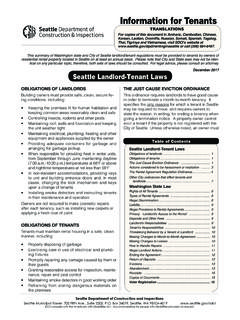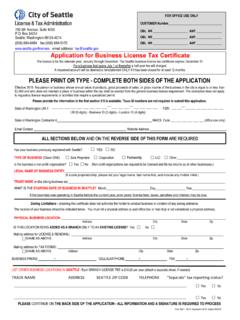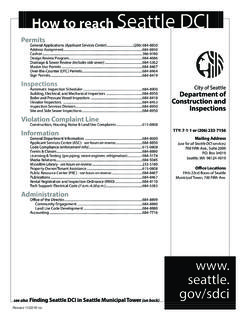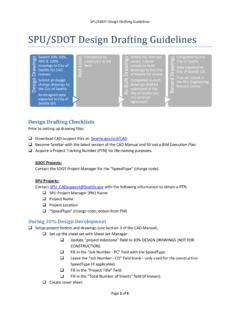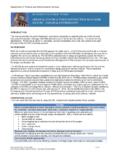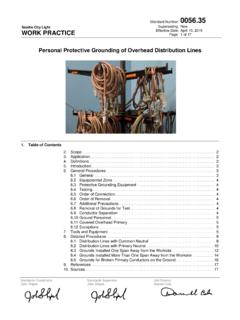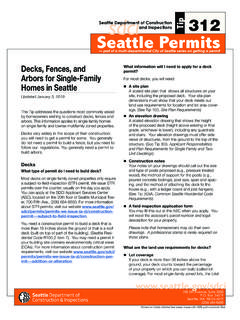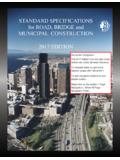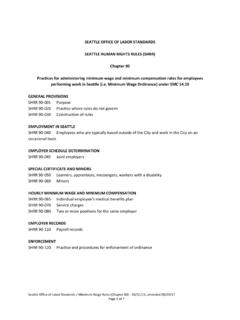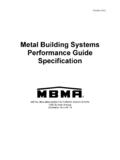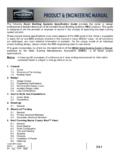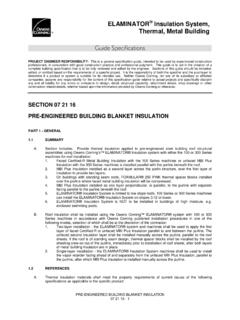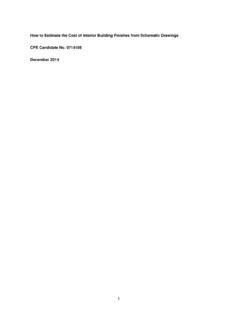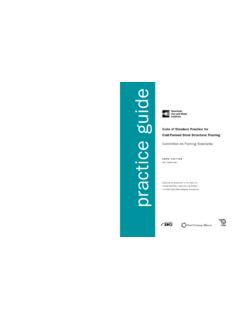Transcription of Post-Permit Submittals – Shop Drawing Requirements
1 S Post-Permit Submittals Shop Drawing Requirements Applicants are responsible for insuring that their submittal meets these relevant standards prior to intake. The limited time of intake is not intended for applicants to complete their application materials. For additional Requirements , see the Post-Permit Submittals Screening Checklist. There are different types of Post-Permit Submittals : Blanket Permits, Revisions, Shop Drawings and Sprinkler Drawings. Post-Permit Shop Drawing Submittals for finaled or expired permits will not be accepted. All design engineers, Engineers of Record and Architects of Record involved with shop Drawing design, review and approval shall be registered professionals, meeting the Seattle building Code (SBC) Section 202 definition.
2 After a building permit has been issued, Post-Permit shop Drawing Submittals related to t hat permit may be made directly to Plans Routing. If there is a doubt whether or not a Post-Permit submittal is necessary or will be accepted, consult the building code reviewer for the original permit. Shop Drawings are required for the following building elements: Curtain Wall Systems Hold-down Systems (multi-story threaded rod systems only) metal Buildings, metal building manufacturers association (Note: shop drawings are required in addition to the metal building design drawings that are required at permit application) Post-t ensioned Concrete Systems Precast Concrete Piles Precast Prestressed Elements (planks, etc.) Special Designs (large skylights, canopies, base i solators, etc.)
3 Spray Applied Fire Proofing Stairs, Prefabricated (except when part of single family/duplex or Seattle Residential Code townhouses) Steel Joists and Joist Girders, Steel Joist Institute Storage Racks (greater than or equal to 6 feet in height) Sunrooms (except when part of single family/duplex or Seattle Residential Code townhouses) Wood Trusses, metal Plate Connected (Note: shop drawings for Seattle Residential Code townhouse or single family/duplex structures do not require Seattle DCI review, however, the shop drawings must be provided at the project site) Shop Drawings are NOT required for the following building elements: Stairs, Prefabricated (when part of Seattle Residential Code townhouse or single family/duplex structures) Steel Decking Structural Steel Sunrooms (when part of Seattle Residential Code townhouse or single family/duplex structures) Wood Beams, Prefabricated, American Institute of Timber Construction Wood Joist (plywood web) Wood Panels, Prefabricated City of Seattle Department of Construction and Inspections MINOR TELECOMM Drop-Off Submittal Post-Permit Submittals INDEX 16 Applicant Service Center700 Fifth Avenue, 20th Floor Seattle, WA 98124-4019 Phone: (206) 684-8850 SCREENING STANDARDS Revised 01/01/2016 Page 2 of 4 SCREENING STANDARDS Post-Permit Submittals INDEX 16 Shop Drawings Specific RequirementsAll Shop Drawing Types.
4 Every shop Drawing sheet shall be stamped by the design engineer. Every shop Drawing sheet shall be reviewed and stamped by the Engineer of Record (or Architect of Record for Spray Applied Fire Proofing). -OR-There shall be an index sheet stamped by the Engineer of Record (or Architect of Record for SprayApplied Fire Proofing). Along with the review stamp, the index sheet shall have a statementindicating which sheets have been reviewed and approved by the Engineer of Record. The stamp orstatement shall substantially state that the shop drawings have been reviewed for connections andloading to the building structure and design criteria. Any sheet on which the Engineer of Record (orArchitect of Record) has comments shall bear the review stamp along with the comments and sheetdisposition status.
5 No drawings should be submitted to the building official that still bears thedisposition of revise and resubmit or similar calculations are provided, the Engineer or Architect of Record shall review, approve, stamp, initial and date the cover sheet of the calculations. The cover sheet of the calculations shall also be stamped by the design engineer. Curtain Wall or Exterior Cladding Systems: General size and configuration of system. For curtain wall systems used on low-rise, mid-rise and high-rise buildings, Seattle DCI requires that one of the following conditions is met: 1) The curtain wall system shall be designed by a registered structural engineer licensed to prac tice in the State of ) The curtain wall system shall be designed by a registered professional (civil) engineer licensed to practice in the State of Washington provided the engineer has a minimum of 5-years of structural design experience in the curtain wall industry.
6 A stamped letter from the design engineer requesting recognition as a specialty product design engineer and the design engineer s resume shall be submitted to Seattle DCI for review and specialty anchoring systems are used to support the curtain wall on high-rise buildings: For all exterior cladding systems installed on high-rise buildings, buildings having occupied floors located more than 75 feet above the lowest level of fire department vehicle access, the City of Seattle DCI requires that the curtain wall design engineer provide a current ICC-ES report for all specialty anchoring systems and/or devices used t o connect those systems to t he main building structure. It is further required that the design calculations clearly show that the anchor capacity provided or calculated per the provisions and tables of the ICC-ES report meet or exceed the worst case imposed gravity and lateral load combination to the connection as required.
7 If the specialty anchoring system manufacturer does not have a current ICC-ES report for his particular product or products, he shall provide the curtain wall design engineer with test data and supporting calculations stamped by a registered professional engineer currently licensed to practice in the State of Washington. The curtain wall design engineer shall then: 1)Review and approve the stamped test data and supporting calculations provided by the specialty anchoring system manufacturer;2)Provide his shop Drawing review stamp on the cover sheet of the documents;3)Provide Seattle DCI with a stamped letter stating that he accepts the results of the stamped anchoring product test data and supporting calculations for the project;4)Verify in his calculations that the allowable loads given in the documentation provided by the specialty anchoring system manufacturer meet or exceed the worst case gravity and lateral load combination to the connections as required.
8 Revised 01/01/2016 Page 3 of 4 SCREENING STANDARDS Post-Permit Submittals INDEX 16 The structural engineer of record for the building shall also review, approve, review stamp, initial and date the cover sheet of the specialty anchoring system manufacturer s test data and supporting calculations as well as review, approve and review stamp, initial and date the exterior cladding system shop drawings and the cover sheet of the supporting calculations as previously required. Where specialty anchoring systems are used to support exterior cladding on low-rise or mid-rise buildings: For all exterior cladding systems installed on low-rise or mid-rise buildings, Seattle DCI requires that the design engineer provide a current ICC-ES report or a report from certified listing agency for all specialty anchoring systems and/or devices used to connect those systems to the main building structure.
9 It is further required that the design calculations clearly show that the anchor capacity provided or calculated per the provisions and tables of the ICC-ES report or the report of the certified listing agency, meet or exceed the worst case imposed gravity and lateral load combination to the connection as required. If a specialty anchoring system is used to support the exterior cladding system and a current ICC-ES report or a current report from certified listing agency cannot be provided for the particular product or products, the design engineer shall accept full responsibility for the specialty anchoring system by providing his stamp on each sheet of the design/shop drawings and the cover sheet of the calculations as normally required. The statement By Others will not be accepted at those locations where the specialty anchoring system connections are shown on the design/shop drawings.
10 The design engineer shall also provide Seattle DCI with a Code Alternate form for review and approval stating his intention to use the specialty anchoring system to connect the exterior cladding to the main building structure, and clearly state he accepts full responsibility for their performance. Threaded Rod Hold-down Systems: Load table clearly outlining the required maximum hold-down forces for each shear wall type and location or loads clearly shown on the permit plan sheets, general details from the ICC-ES report for the hold-down system, any other details deemed necessary by the structural engineer, , manufacturer s catalog cuts, unusual construction conditions, etc. The hold-down system design engineer must be a licensed professional engineer in accordance with SBC The hold-down system design engineer shall clearly indicate in the calculations that the allowable loads stated in the ICC-ES report meet or exceed the imposed worst case load combination for each load case provided by the structural engineer of record.
